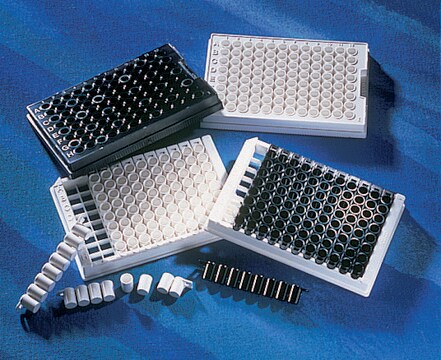P0194
Protein Kinase Cζ isozyme human
≥75% (SDS-PAGE), recombinant, expressed in baculovirus infected insect cells, buffered aqueous solution
Sinonimo/i:
Ca2+-activated phospholipid-dependent serine-threonine kinase ζ isozyme human, PKCζ human
About This Item
Prodotti consigliati
Ricombinante
expressed in baculovirus infected insect cells
Livello qualitativo
Saggio
≥75% (SDS-PAGE)
Forma fisica
buffered aqueous solution
enzyme activity
>800 units/mg protein
PM
76-80 kDa by SDS-PAGE
N° accesso UniProt
Condizioni di spedizione
dry ice
Temperatura di conservazione
−70°C
Informazioni sul gene
human ... PRKCZ(5590)
Azioni biochim/fisiol
Phosphorylation appears to be an important mechanism of regulation of all PKCs. PKC plays a role in the regulation of cell transformation, growth, differentiation, ruffling, vesicle trafficking, apoptosis and gene expression.
Compatibilità
Definizione di unità
Stato fisico
Codice della classe di stoccaggio
10 - Combustible liquids
Classe di pericolosità dell'acqua (WGK)
WGK 1
Punto d’infiammabilità (°F)
Not applicable
Punto d’infiammabilità (°C)
Not applicable
Dispositivi di protezione individuale
Eyeshields, Gloves, multi-purpose combination respirator cartridge (US)
Certificati d'analisi (COA)
Cerca il Certificati d'analisi (COA) digitando il numero di lotto/batch corrispondente. I numeri di lotto o di batch sono stampati sull'etichetta dei prodotti dopo la parola ‘Lotto’ o ‘Batch’.
Possiedi già questo prodotto?
I documenti relativi ai prodotti acquistati recentemente sono disponibili nell’Archivio dei documenti.
Il team dei nostri ricercatori vanta grande esperienza in tutte le aree della ricerca quali Life Science, scienza dei materiali, sintesi chimica, cromatografia, discipline analitiche, ecc..
Contatta l'Assistenza Tecnica.






